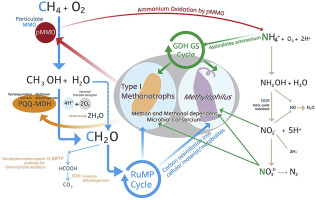Water Research ( IF 12.8 ) Pub Date : 2020-01-20 , DOI: 10.1016/j.watres.2020.115512 I-Tae Kim , Ye-Eun Lee , Yoonah Jeong , Yeong-Seok Yoo

|
This study proposes a novel method to directly treat reject water with a high ammonium content, without relying on dilution. The originality of this method resides in leveraging the coordinated action of a methane- and methanol-dependent bacterial consortium and the biogas generated from wastewater treatment facilities. Specifically, ammonium is removed through autotrophic assimilation in the glutamate cycle of methanotrophs and Methylophilus while, simultaneously, methanol generated by methanotrophs is treated through formaldehyde assimilation as Methylophilus undergo the same ribulose monophosphate cycle as methanotrophs. Using this method, the backflow of high-concentration ammonium into the wastewater treatment process was reduced to 59% in a single operation using a sequencing batch reactor at a mean influent concentration of 877.3 mg L−1. However, the removal rate temporarily declined to an average of 37.6% at a concentration of 800 mg L−1 or above, which was imputed to the influence of toxic intermediates.
中文翻译:

使用依赖于甲烷和甲醇的细菌联合体从废水处理厂的废水中去除氮的新方法
这项研究提出了一种新颖的方法,可以直接处理具有高铵含量的废水,而无需依靠稀释。该方法的独创性在于利用依赖甲烷和甲醇的细菌联合体与废水处理设施产生的沼气的协同作用。具体而言,铵是通过在甲烷氧化和谷氨酸周期自养同化去除食甲基而,同时,由甲烷氧化生成的甲醇通过甲醛同化作为处理过的食甲基经历与甲基营养生物相同的核糖一磷酸循环。使用该方法,使用测序间歇反应器在一次操作中,平均进水浓度为877.3 mg L -1时,高浓度铵进入废水处理过程的回流减少到59%。但是,在800mg L -1以上的浓度下,去除率暂时下降至平均37.6%,这归因于毒性中间体的影响。



























 京公网安备 11010802027423号
京公网安备 11010802027423号